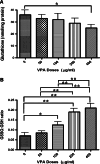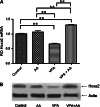Ascorbic acid reverses valproic acid-induced inhibition of hoxa2 and maintains glutathione homeostasis in mouse embryos in culture
- PMID: 19655241
- PMCID: PMC11498376
- DOI: 10.1007/s10571-009-9438-7
Ascorbic acid reverses valproic acid-induced inhibition of hoxa2 and maintains glutathione homeostasis in mouse embryos in culture
Abstract
Valproic acid (VPA) has been shown to cause neural tube defects in humans and mice, but its mechanism of action has not been elucidated. We hypothesize that alterations in embryonic antioxidant status and Hoxa2 gene expression play an important role in VPA-induced teratogenesis. A whole embryo culture system was applied to explore the effects of VPA on total glutathione, on glutathione in its oxidized (GSSG) and reduced (GSH) forms [GSSG/GSH ratio] and on Hoxa2 expression in cultured CD-1 mouse embryos during their critical period of organogenesis. Our results show that VPA can (1) induce embryo malformations including neural tube defects, abnormal flexion, yolk sac circulation defects, somite defects, and craniofacial deformities such as fusion of the first and second arches, and (2) alter glutathione homeostasis of embryos through an increase in embryonic GSSG/GSH ratio and a decrease in total GSH content in embryos. Western blot analysis and quantitative real-time RT-PCR show that VPA can inhibit Hoxa2 expression in cultured embryos at both the protein and mRNA level, respectively. The presence of ascorbic acid in the culture media was effective in protecting embryos against oxidative stress induced by VPA and prevented VPA-induced inhibition of Hoxa2 gene expression. Hoxa2 null mutant embryos do not exhibit altered glutathione homeostasis, indicating that inhibition of Hoxa2 is downstream of VPA-induced oxidative stress. These results are first to suggest VPA may, in part, exert its teratogenicity through alteration of the embryonic antioxidant status and inhibition of Hoxa2 gene expression and that ascorbic acid can protect embryos from VPA-induced oxidative stress.
Figures





Similar articles
-
Valproic acid promotes SOD2 acetylation: a potential mechanism of valproic acid-induced oxidative stress in developing systems.Free Radic Res. 2021 Dec;55(11-12):1130-1144. doi: 10.1080/10715762.2021.2017913. Epub 2022 Jan 19. Free Radic Res. 2021. PMID: 34895005
-
Spatiotemporal evaluation of the mouse embryonic redox environment and histiotrophic nutrition following treatment with valproic acid and 1,2-dithiole-3-thione during early organogenesis.Reprod Toxicol. 2021 Apr;101:81-92. doi: 10.1016/j.reprotox.2021.03.001. Epub 2021 Mar 10. Reprod Toxicol. 2021. PMID: 33713778 Free PMC article.
-
NRF2 activation inhibits valproic acid-induced neural tube defects in mice.Neurotoxicol Teratol. 2022 Jan-Feb;89:107039. doi: 10.1016/j.ntt.2021.107039. Epub 2021 Oct 29. Neurotoxicol Teratol. 2022. PMID: 34737154
-
Teratogenic effects of valproic acid and diphenylhydantoin on mouse embryos in culture.Teratology. 1983 Feb;27(1):29-42. doi: 10.1002/tera.1420270106. Teratology. 1983. PMID: 6405496
-
Multiple point action mechanism of valproic acid-teratogenicity alleviated by folic acid, vitamin C, and N-acetylcysteine in chicken embryo model.Toxicology. 2012 Jan 27;291(1-3):32-42. doi: 10.1016/j.tox.2011.10.015. Epub 2011 Oct 25. Toxicology. 2012. PMID: 22051200
Cited by
-
Upregulation of ACSL, ND75, Vha26 and sesB genes by antiepileptic drugs resulted in genotoxicity in drosophila.Toxicol Res (Camb). 2024 Nov 5;13(6):tfae180. doi: 10.1093/toxres/tfae180. eCollection 2024 Dec. Toxicol Res (Camb). 2024. PMID: 39507589
-
Exploring the Validity of Valproic Acid Animal Model of Autism.Exp Neurobiol. 2015 Dec;24(4):285-300. doi: 10.5607/en.2015.24.4.285. Epub 2015 Dec 16. Exp Neurobiol. 2015. PMID: 26713077 Free PMC article. Review.
-
Prevention of Teratogenesis in Pregnancies of Obese Rats by Vitamin E Supplementation.Antioxidants (Basel). 2021 Jul 23;10(8):1173. doi: 10.3390/antiox10081173. Antioxidants (Basel). 2021. PMID: 34439421 Free PMC article.
-
Congenital malformation and autism spectrum disorder: Insight from a rat model of autism spectrum disorder.Indian J Pharmacol. 2017 May-Jun;49(3):243-249. doi: 10.4103/ijp.IJP_183_17. Indian J Pharmacol. 2017. PMID: 29033484 Free PMC article.
-
Rewriting the epigenetic code for tumor resensitization: a review.Transl Oncol. 2014 Oct 24;7(5):626-31. doi: 10.1016/j.tranon.2014.08.003. eCollection 2014 Oct. Transl Oncol. 2014. PMID: 25389457 Free PMC article. Review.
References
-
- Al Deeb S, Al Moutaery K, Arshaduddin M, Tariq M (2000) Vitamin E decreases valproic acid induced neural tube defects in mice. Neurosci Lett 292:179–182 - PubMed
-
- Allen RG (1991) Oxygen-reactive species and antioxidant responses during development: the metabolic paradox of cellular differentiation. Proc Soc Exp Biol Med 196:117–129 - PubMed
-
- Aoki Y, Okada A, Fujiwara M (2001) In vitro effects of anti-epileptic drugs (AEDs) on HOX gene expression in human EC cell line NT2/D1. The Japanese teratology society, 41st annual meeting, Congenit. Anomal (Kyoto), Abstract # O-38, 41:249
-
- Baker MA, Cerniglia GJ, Zaman A (1990) Microtiter plate assay for the measurement of glutathione and glutathione disulfide in large numbers of biological samples. Anal Biochem 190:360–365 - PubMed
Publication types
MeSH terms
Substances
LinkOut - more resources
Full Text Sources
Medical

